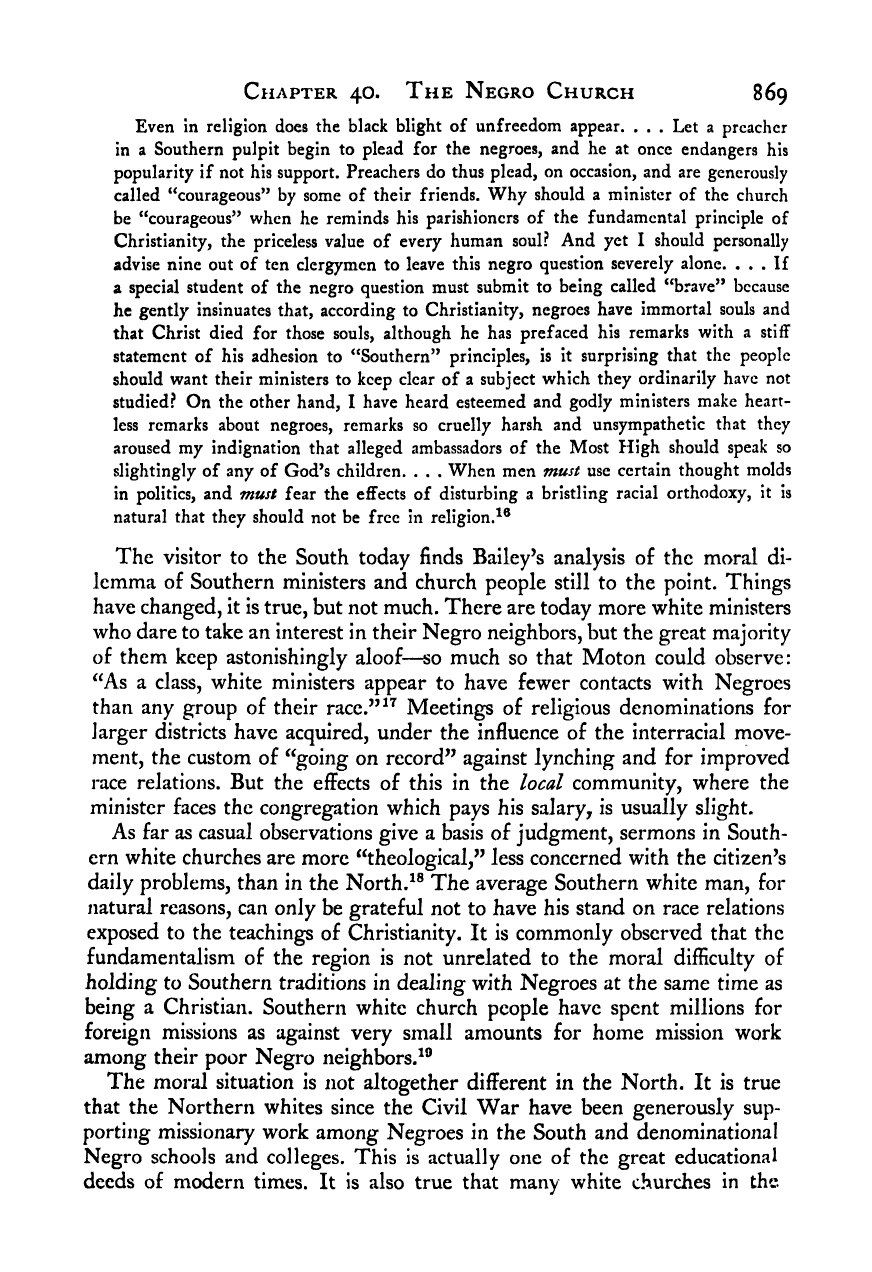Note: Gunnar Myrdal died in 1987, less than 70 years ago. Therefore, this work is protected by copyright, restricting your legal rights to reproduce it. However, you are welcome to view it on screen, as you do now. Read more about copyright.
Full resolution (TIFF) - On this page / på denna sida - IX. Leadership and Concerted Action - 40. The Negro Church - 4. A Segregated Church

<< prev. page << föreg. sida << >> nästa sida >> next page >>
Below is the raw OCR text
from the above scanned image.
Do you see an error? Proofread the page now!
Här nedan syns maskintolkade texten från faksimilbilden ovan.
Ser du något fel? Korrekturläs sidan nu!
This page has never been proofread. / Denna sida har aldrig korrekturlästs.
Chapter 40. The Negro Church 869
Even In religion does the black blight of unfreedom appear. . . . Let a preacher
in a Southern pulpit begin to plead for the negroes, and he at once endangers his
popularity if not his support. Preachers do thus plead, on occasion, and are generously
called “courageous” by some of their friends. Why should a minister of the church
be “courageous” when he reminds his parishioners of the fundamental principle of
Christianity, the priceless value of every human soul? And yet I should personally
advise nine out of ten clergymen to leave this negro question severely alone. ... If
a special student of the negro question must submit to being called “brave” because
he gently insinuates that, according to Christianity, negroes have immortal souls and
that Christ died for those souls, although he has prefaced his remarks with a stiff
statement of his adhesion to “Southern” principles, is it surprising that the people
should want their ministers to keep clear of a subject which they ordinarily have not
studied? On the other hand, I have heard esteemed and godly ministers make heart-
less remarks about negroes, remarks so cruelly harsh and unsympathetic that they
aroused my indignation that alleged ambassadors of the Most High should speak so
slightingly of any of God’s children. . . . When men must use certain thought molds
in politics, and must fear the effects of disturbing a bristling racial orthodoxy, it is
natural that they should not be free in religion.^®
The visitor to the South today finds Bailey’s analysis of the moral di-
lemma of Southern ministers and church people still to the point. Things
have changed, it is true, but not much. There are today more white ministers
who dare to take an interest in their Negro neighbors, but the great majority
of them keep astonishingly aloof—so much so that Moton could observe:
^^As a class, white ministers appear to have fewer contacts with Negroes
than any group of their race.”^^ Meetings of religious denominations for
larger districts have acquired, under the influence of the interracial move-
ment, the custom of ^^going on record” against lynching and for improved
race relations. But the effects of this in the local community, where the
minister faces the congregation which pays his salary^ is usually slight.
As far as casual observations give a basis of judgment, sermons in South-
ern white churches are more ^^theological,” less concerned with the citizen’s
daily problems, than in the North. The average Southern white man, for
natural reasons, can only be grateful not to have his stand on race relations
exposed to the teachings of Christianity. It is commonly observed that the
fundamentalism of the region is not unrelated to the moral difficulty of
holding to Southern traditions in dealing with Negroes at the same time as
being a Christian. Southern white church people have spent millions for
foreign missions as against very small amounts for home mission work
among their poor Negro neighbors.’®
The moral situation is not altogether different in the North. It is true
that the Northern whites since the Civil War have been generously sup-
porting missionary work among Negroes in the South and denominational
Negro schools and colleges. This is actually one of the great educational
deeds of modern times. It is also true that many white churches in the
<< prev. page << föreg. sida << >> nästa sida >> next page >>